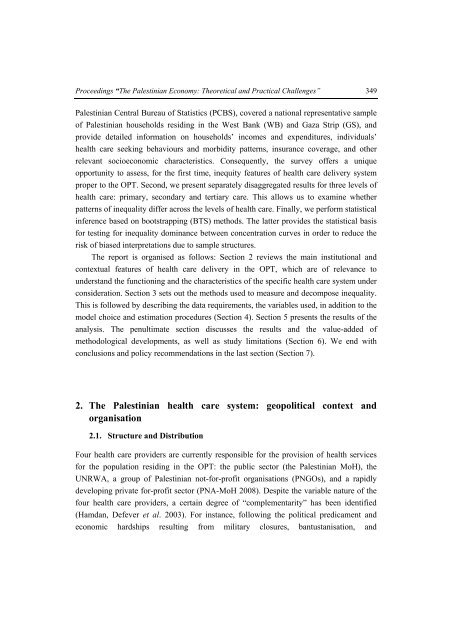The Palestinian Economy. Theoretical and Practical Challenges
The Palestinian Economy. Theoretical and Practical Challenges
The Palestinian Economy. Theoretical and Practical Challenges
You also want an ePaper? Increase the reach of your titles
YUMPU automatically turns print PDFs into web optimized ePapers that Google loves.
Proceedings “<strong>The</strong> <strong>Palestinian</strong> <strong>Economy</strong>: <strong>The</strong>oretical <strong>and</strong> <strong>Practical</strong> <strong>Challenges</strong>” 349<br />
<strong>Palestinian</strong> Central Bureau of Statistics (PCBS), covered a national representative sample<br />
of <strong>Palestinian</strong> households residing in the West Bank (WB) <strong>and</strong> Gaza Strip (GS), <strong>and</strong><br />
provide detailed information on households’ incomes <strong>and</strong> expenditures, individuals’<br />
health care seeking behaviours <strong>and</strong> morbidity patterns, insurance coverage, <strong>and</strong> other<br />
relevant socioeconomic characteristics. Consequently, the survey offers a unique<br />
opportunity to assess, for the first time, inequity features of health care delivery system<br />
proper to the OPT. Second, we present separately disaggregated results for three levels of<br />
health care: primary, secondary <strong>and</strong> tertiary care. This allows us to examine whether<br />
patterns of inequality differ across the levels of health care. Finally, we perform statistical<br />
inference based on bootstrapping (BTS) methods. <strong>The</strong> latter provides the statistical basis<br />
for testing for inequality dominance between concentration curves in order to reduce the<br />
risk of biased interpretations due to sample structures.<br />
<strong>The</strong> report is organised as follows: Section 2 reviews the main institutional <strong>and</strong><br />
contextual features of health care delivery in the OPT, which are of relevance to<br />
underst<strong>and</strong> the functioning <strong>and</strong> the characteristics of the specific health care system under<br />
consideration. Section 3 sets out the methods used to measure <strong>and</strong> decompose inequality.<br />
This is followed by describing the data requirements, the variables used, in addition to the<br />
model choice <strong>and</strong> estimation procedures (Section 4). Section 5 presents the results of the<br />
analysis. <strong>The</strong> penultimate section discusses the results <strong>and</strong> the value-added of<br />
methodological developments, as well as study limitations (Section 6). We end with<br />
conclusions <strong>and</strong> policy recommendations in the last section (Section 7).<br />
2. <strong>The</strong> <strong>Palestinian</strong> health care system: geopolitical context <strong>and</strong><br />
organisation<br />
2.1. Structure <strong>and</strong> Distribution<br />
Four health care providers are currently responsible for the provision of health services<br />
for the population residing in the OPT: the public sector (the <strong>Palestinian</strong> MoH), the<br />
UNRWA, a group of <strong>Palestinian</strong> not-for-profit organisations (PNGOs), <strong>and</strong> a rapidly<br />
developing private for-profit sector (PNA-MoH 2008). Despite the variable nature of the<br />
four health care providers, a certain degree of “complementarity” has been identified<br />
(Hamdan, Defever et al. 2003). For instance, following the political predicament <strong>and</strong><br />
economic hardships resulting from military closures, bantustanisation, <strong>and</strong>
















